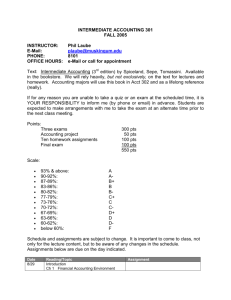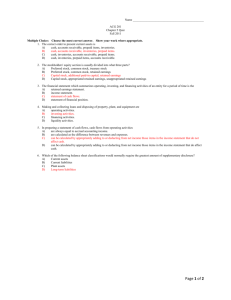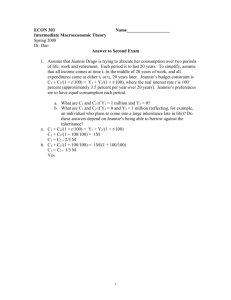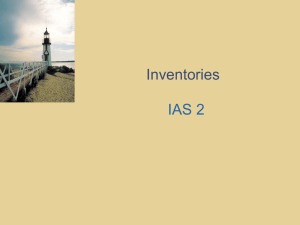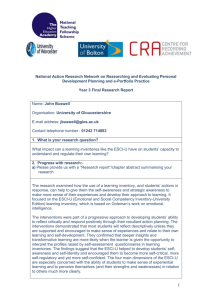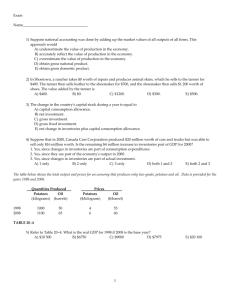Year 12 accounting term 2 internal controls
advertisement
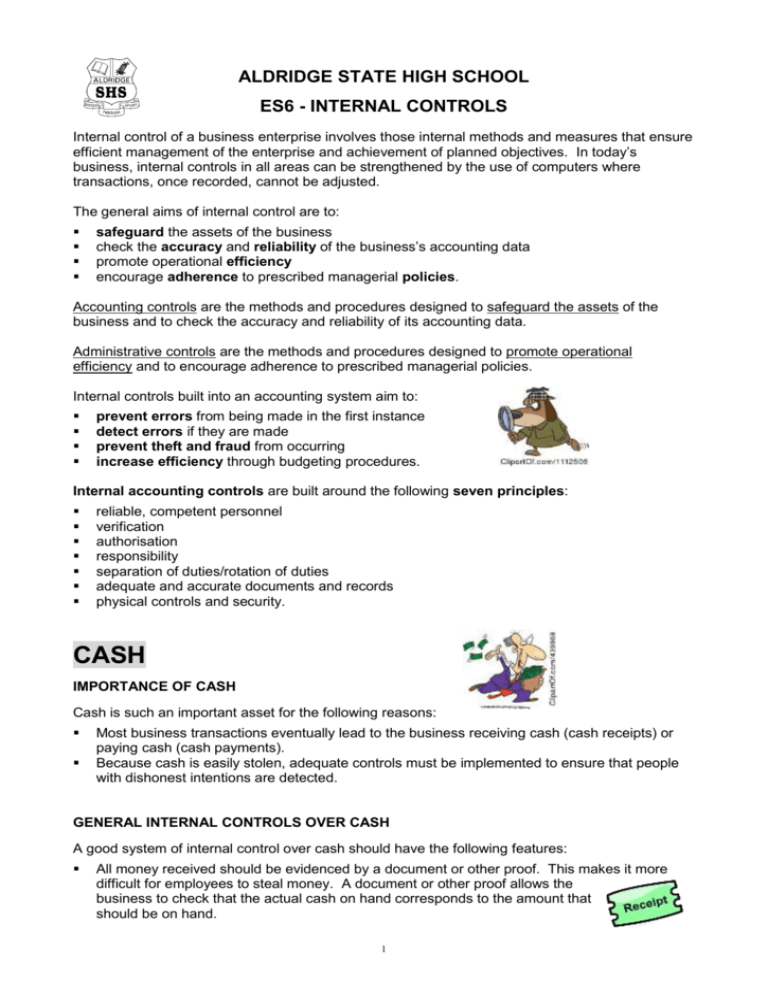
ALDRIDGE STATE HIGH SCHOOL ES6 - INTERNAL CONTROLS Internal control of a business enterprise involves those internal methods and measures that ensure efficient management of the enterprise and achievement of planned objectives. In today’s business, internal controls in all areas can be strengthened by the use of computers where transactions, once recorded, cannot be adjusted. The general aims of internal control are to: safeguard the assets of the business check the accuracy and reliability of the business’s accounting data promote operational efficiency encourage adherence to prescribed managerial policies. Accounting controls are the methods and procedures designed to safeguard the assets of the business and to check the accuracy and reliability of its accounting data. Administrative controls are the methods and procedures designed to promote operational efficiency and to encourage adherence to prescribed managerial policies. Internal controls built into an accounting system aim to: prevent errors from being made in the first instance detect errors if they are made prevent theft and fraud from occurring increase efficiency through budgeting procedures. Internal accounting controls are built around the following seven principles: reliable, competent personnel verification authorisation responsibility separation of duties/rotation of duties adequate and accurate documents and records physical controls and security. CASH IMPORTANCE OF CASH Cash is such an important asset for the following reasons: Most business transactions eventually lead to the business receiving cash (cash receipts) or paying cash (cash payments). Because cash is easily stolen, adequate controls must be implemented to ensure that people with dishonest intentions are detected. GENERAL INTERNAL CONTROLS OVER CASH A good system of internal control over cash should have the following features: All money received should be evidenced by a document or other proof. This makes it more difficult for employees to steal money. A document or other proof allows the business to check that the actual cash on hand corresponds to the amount that should be on hand. 1 All cash received should be banked intact at the end of each business day. “Intact” means that payments should not be made out of the day’s receipts. Banking daily ensures that large amounts of money will therefore not be left on the premises overnight. All cash payments should be made by cheque or electronic funds transfer (EFT) except when amounts are small enough to be paid through a petty cash fund. All cash should be kept in a safe place. Change kept on hand for the next working day should be under lock and key, preferably in a safe. At regular intervals, the business’s records must be checked against, or reconciled with, an independent record called a bank statement. This is particularly important where there are many EFTs of cash. If this occurs, the receipt of daily bank statements or Internet access to bank statements is very important. Bank statements are vital, not only to ensure the reconciliation of the final balance, but also to record the many transactions that are now occurring electronically. Employees who receive or handle cash should not be involved with the recording of these transactions in the accounting records. This separation of duties is designed to prevent a person from taking money and disguising the theft by adjusting the business’s records. Employees are less likely to commit fraud if they know that they can be moved without prior notice. This rotation of duties may allow the next person doing the job to discover any unusual entries. Employees should also be made to take annual holidays so that other people do their job in their absence. Again, errors or unusual entries can be discovered in this way. CREDIT IMPORTANCE OF CREDIT Control over credit is becoming more important because of the tendency to rely less on cash and to use credit cards and credit facilities provided. Many business transactions are carried out on a credit basis, such as the purchasing and selling of inventories. These credit transactions create accounts receivable and payable and adequate controls must be implemented over them. INTERNAL CONTROL OVER ACCOUNTS RECEIVABLE Credit approval: All customers who apply for credit must be thoroughly investigated for their credit worthiness. Such things as permanent employment or length of time in business, amount of income/profit, permanent residence, ability to pay debts, past credit history and credit ratings from other firms must be looked at before credit is given. This investigation is essential, because if credit is given to the wrong people, there is an increased risk of bad debts occurring. The business must have a credit policy and must decide the following: what the minimum requirements will be before credit is granted the number of days given for accounts receivable to pay whether or not discounts will be given the amount of interest (if any) that will be charged on overdue accounts 2 In larger businesses, these functions are generally carried out by a credit department. Credit approval must always be the responsibility of the finance section and not the responsibility of the sales section. In this way, salespeople are not tempted to adjust a person’s credit rating simply to get a sale. When a credit sale is made, it is important that salespeople check the credit status of the potential customer. Recording The use of control accounts and subsidiary ledgers is desirable where the number of accounts warrant their use. This control occurs through comparison of the schedule of accounts receivable with the control account in the general ledger. Billing A tax invoice is the main document that certifies a credit sale has taken place. An adjustment/credit note certifies that a sales return or allowance has occurred. As well, statements of account should be sent at regular intervals to accounts receivable so that cash from these credit sales is collected as soon as possible. A statement of account is simply a list of the transactions (goods sold on credit, cash received and so on) that have occurred and is in the same form as a three-column ledger. Statements of account also help to ensure that the business’s records are correct, as most people receiving an incorrect statement will contact the firm. This, in conjunction with spot checks made by the accountant or internal auditor to see that statements of account agree with actual accounts receivable balance, help ensure that the business’s accounting records are accurate. If there is a large number of accounts receivable, a technique called cycle billing may be used. Instead of sending out all accounts receivable at the end of each month and have a very heavy workload at that time, cycle billing spreads this workload over the whole month. Customers are grouped alphabetically and statements are sent out in a cycle during the month. For example, statements for accounts receivable whose names start with A-F will be sent out on the first day of every month, G-L on the 8th, M-S on the 15th and T-Z on the 22nd. Reporting Each accounts receivable must be monitored to ensure that debts are paid on time. The most common technique used is called “ageing the accounts receivable”. A report is prepared setting out the age of each account as current, up to 30 days past the due date, 60 days past the due date and so on. This report identifies slow-paying customers so that appropriate action can be taken. The older the debt, the less likely it is that the account will be paid. Accounts receivable must therefore be constantly reminded of the debt. Generally, accounts receivable are contacted by telephone and/or reminder notices (varying in degrees of tact) are sent with overdue accounts. For example, the first reminder may say, “Perhaps you have overlooked this account, please pay promptly”. The final letter may say, “If payments are not received within 21 days, court action will be taken”. If all procedures fail to collect the money owing, the account may have to be written off as a bad debt. Separation of duties This is a very important principle of internal control. No person who handles the physical assets of cash or inventories should also have access to the accounts receivable records. This is to ensure that assets are not removed illegally and the records adjusted to cover up the fraud. 3 INTERNAL CONTROL OVER ACCOUNTS PAYABLE Proper authorisation This should be obtained before goods are ordered. Suppliers should be approved on the basis of price, quality and the ability to fill orders on time. Proper authorisation must also be obtained before cheques are drawn to pay accounts. This ensures that each accounts payable is paid the correct amount. Recording The use of control accounts and subsidiary ledgers (if suited to the style of the business) allows greater control through comparison of the control account in the general edger with the schedule of accounts payable. Prompt payment Procedures should be implemented to ensure that payments are made promptly, especially within any discount periods. This means that the business takes advantage of any discounts and maintains its reputation for prompt payments. Separation of duties People who handle the accounts payable records should not handle the payment of cash or the receipt of inventories. INVENTORIES IMPORTANCE OF INVENTORIES Inventories are important for several reasons. They are an integral part of profit determination. They are used in calculating any inventory adjustment to be included in cost of goods sold and therefore have a great bearing on the profit figure. Gross profit = Sales – Cost of goods sold A figure for closing inventories must be obtained so that the Balance Sheet can be accurately prepared. Closing inventories are one of the items of value owned on balance day. Inventories should be turned over as quickly as possible. The faster the turnover (sales), the greater the opportunity to make profits. Because large amounts of money are invested in inventories, adequate controls must be implemented so that theft and other losses are kept to a minimum. Store cameras, store detectives, inspection of shopping bags and mirrors are methods used to prevent theft by customers. The quantity of inventories must be continually monitored. Neither too many nor too few inventories should be kept on hand. If the level of inventories held by the business is too high and goods are not selling, then money is being tied up and not being used to generate profit. This is why many businesses have a clearance sale – to reduce the price and convert slow-moving inventories to cash so that faster-moving inventories can be purchased. If the level of inventories held by the business is too low, sales will be lost to competitors and goodwill will diminish. 4 The quality and type of inventories are very important. The business should try to have available for sale the right goods, at the right place, at the right time. A constant check must be made to ensure that inventories are not out of date, the wrong colour or size, or of poor quality, otherwise sales will suffer. Also, the procedures for controlling inventories depends on the size of the business: If the business is large, these functions are shared between different departments and internal controls must be built into the system. If the business is small, each of the functions could be performed and supervised by the owner so that control measures are more easily implemented. Stocktaking (physical stocktake or physical inventory) If a business keeps inventories as part of its normal operation, an annual physical stocktake is a necessity. Stocktaking is the process of listing, counting and valuing unsold inventories on hand. A stocktake is necessary for two main reasons: It is needed to determine the value of the inventories on hand at a particular date. This value is used in the Balance Sheet. It is the only way of determining actual inventories on hand. If the perpetual inventory system is used, the figure arrived at can also be compared with what should have been on hand. It can them be seen whether goods have been lost through theft or spoilage. INTERNAL CONTROL OVER THE PURCHASE OF INVENTORIES The ordering of goods is dependent upon three factors: the reorder point, which is a predetermined minimum amount of an item that a business would like to maintain the reorder quantity, which is the quantity to be ordered when the reorder point is reached the lead time, which is the amount of time it takes from when a business places an order to when the product actually arrives. Generally, the longer the lead time (if, for example, the goods have to come from overseas), the higher the reorder point and the higher the reorder quantity. The shorter the lead time (if, for example, the supplier is in the same city), the lower the reorder point and the lower the reorder quantity. When the goods are ordered, a purchase order or an order form is despatched to the supplier. When the goods are received, a delivery docket or despatch docket will accompany the goods. Care must be taken to ensure that the goods received are in fact the goods ordered. An original tax invoice may be received at the time of delivery or at a later date. If goods are returned by us (purchases returns), an original adjustment/credit note will be received. 5 INTERNAL CONTROL OVER THE SALE OF INVENTORIES Orders may be received over the counter, by post, by telephone, from travelling salespeople or electronically by electronic data interchange (EDI) or from a website. If orders are not received electronically, they are generally entered onto a standardised sales order to be processed by the organisation. When the order is filled, details of the transaction are recorded on an original tax invoice and an original despatch docket. The original despatch docket will accompany the goods and the original tax invoice can accompany the goods or be sent later. Copies are kept by our business. If goods are returned to us (sales returns), an original adjustment/credit note will be sent and a copy kept by us. If goods are sold for cash, a cash register summary is generally used. INTERNAL CONTROL OVER STORED INVENTORIES Because inventories represent such a large investment by the business, loss through theft, damage, deterioration or obsolescence lead to lower sales and therefore lower profit. Adequate controls must therefore be implemented. These controls are generally exercised over location, security and turnover. Location Inventories should be warehoused where they are readily accessible by those people authorised to handle them. At each location, inventories of a similar nature should be stored together. In a retail situation, the goods should be displayed in the most appropriate way in order to maximise exposure, but minimise the risk of loss through theft. Security The warehouse must be locked and only authorised personnel should have access to the keys. Burglar alarms and adequate security staff should be employed. Appropriate documentation must be completed when inventories enter and leave the warehouse. In a retail store, various measures can be adopted to stop pilfering by staff and shoplifting by customers. These include bag inspections, video cameras, dye markers and store detectives. Inventories must be adequately insured. Turnover Inventories should be turned over as quickly as possible. The faster the turnover (sales), the greater the opportunity to make profits. It is most important that measures be taken to ensure that items that are purchased first are sold first. In this way, inventories will be rolled over and old stock will not be left standing on shelves or lying at the bottom of bins. A minimum of one stocktake must be taken each year. Stocktakes determine the amount and condition of inventories on hand. They help to detect slow-moving inventories and those out of date or damaged. Steps may have to be taken to dispose of unsuitable inventories. 6 NON CURRENT ASSETS Non-current assets are assets, other than current assets, that are purchased by the business and are not intended for resale but are used within the operation of the business to earn revenue, and will normally be kept and used for longer than one accounting period. Current assets are those assets which are in the form of cash or will be converted into cash within the financial year, such as inventories and accounts receivable. When non-current assets are classified in the Balance Sheet, they are grouped under the following headings Property, Plant and Equipment, Intangible Assets and Investments. These assets are specifically acquired because they will help the business grow, it is therefore necessary to ensure appropriate controls are implemented over these long-term assets. INTERNAL CONTROLS OVER PROPERTY, PLANT AND EQUIPMENT The most important control over Property, Plant and Equipment is the Property, Plant and Equipment register. When a business has more than one item of Property, Plant and Equipment, it is desirable that a register be kept to record details of each asset. A register enables: Proper control over such assets through the use of the control account/subsidiary ledger technique. Accurate accounting for property, plant and equipment. INTERNAL CONTROLS OVER THE PURCHASE OF PROPERTY, PLANT & EQUIPMENT Authorisation – The purchase of an item of Property, Plant and Equipment is a major decision, therefore requires higher level management to authorise such purchases. Selection – As the purchase of an item of Property, Plant and Equipment will commit the business to large payments of money, it is important all facts are known before purchase. Eg. Performance, reliability, anticipated repair costs, cost of delivery, etc. Proof of ownership – The purchase of Property, Plant and Equipment is usually accompanied by proof of ownership, such as title deeds to property. These need to be kept in a safe or a bank safety deposit box. Payment of cash – Once the purchase is authorised, it becomes a normal cash payment and details are recorded in the Property, Plant and Equipment register. INTERNAL CONTROL OVER THE STORAGE OF PROPERTY, PLANT & EQUIPMENT Location – All assets should be identified by some means, usually by a number. The Property, Plant and Equipment register identifies assets owned and their location. Maintenance – It is essential that all assets are kept in good working order. Protection – The assets need to be protected against theft and damage. Adequate insurance should also be maintained against any unforeseen circumstances. 7 INTERNAL CONTROL OVER THE DISPOSAL OF PROPERTY, PLANT & EQUIPMENT Authorisation – To prevent an unauthorised employee selling valuable assets, proper authorisation must occur when disposing of assets. Physical disposal – This can take place in the form of outright sale, tender, trade-in or scrapping. Whichever method is adopted, the best possible price should be obtained, and this, too, should be authorised. Receipt of cash – For all money received from the disposal of an asset, a receipt must be issued and the money put through the cash receipts journal. Disposal of the asset is then recorded in the Property, Plant and Equipment register. 8 Internal Controls Revision Question Terri Maker owns Merry Music Makers, a music store, and employs an accountant, an accounts clerk, two cash register operators, and a part-time sales assistant. After analysis of the cash, credit and inventories procedures undertaken in her business, she explained the current practices: The cash register operators totalled the cash they received for the day and passed the cash and the receipts to the accountant. The accountant recorded the receipts in the cash receipts journal. Any cash received by mail was recorded and receipted by the accountant in a cash remittance book. The accounts clerk was given the money at the end of the day with a deposit slip already completed by the accountant. If the accounts clerk was too busy, he would lock the cash in the safe for the night and go to the bank whenever he could the next day. On Friday, the part-time sales assistant would be paid in cash from the cash register. Other employees would be paid by cheque or direct deposit. As soon as any invoices were received, the accountant would place them in a folder. At the end of the month, the accountant had the authority and proceeded to prepare and sign the cheques. The accounts clerk kept a petty cash system for small payments. On the rare occasion that the fund did not balance, money was transferred from the cash register to the petty cash fund. Each month a bank statement was received and the accountant was responsible for the reconciliation process. The accountant then informed Ms Maker of the cash position of the business. All staff are trustworthy and are permitted to purchase stock by completing a purchase order form. Any staff member unloads all stock received and stack it on the shelves. The business does not have any way of knowing what stock should be on hand. Overdue account notices are sent out once an account is 60 days overdue. As Ms Maker’s auditor, analyse control, or procedural, weaknesses that you have found and which could be improved. Recommend major processes which need to be addressed. A full explanation is required. Prepare your answer in report format, approximately 600 words, and provide any additional information. 9 INTERNAL CONTROLS EXTRA REVISION QUESTION You work as a junior accountant for Williams and Sons, Chartered Accountants. Your employers have presented the following case study to you. Read the case study and apply your knowledge of accounting internal controls in the areas of cash, inventories, credit transactions and non-current assets to determine whether appropriate procedures have been followed. Give your recommendations to improve the situation. The case study is as follows: Bruton’s Shoe Store, 100 Goondoon Street, Gladstone specialises in selling shoes. Ms Tracy Bruton owns and manages the business which has two full-time employees and two part-time employees. Ms Bruton has asked you to investigate the controls in place in the areas of cash, credit, inventories and non-current assets and make recommendations to improve internal control in these areas. Ms Bruton ensures that all staff frequently try different tasks so they become skilled in most areas. She also allows any of the staff to order stock for the store, by completing an order form when they believe that levels are low. When inventories are received from the supplier, any of the staff available help to unload and store the goods in the storeroom. Ms Bruton bases inventory levels on past experience and the advice of her staff. When the monthly statements are prepared, she makes an estimate at the end of the month for closing inventories, except at the end of the financial year when a complete physical stocktake is undertaken. The Accounts Manager, Michael Dickson, keeps control of all accounts in the business and operates a general ledger only. Michael collects all the money, records all financial transactions, and completes the banking twice a week. The Accounts Clerk, John Charles, is not permitted to enter any accounting data and basically does general office duties, so Michael has more time to do the books. The business has approximately 200 accounts receivable and 100 accounts payable, which are both maintained manually. Accounts payable usually operate on the terms 5/10, n/30 and accounts receivable generally settle accounts within 90 days. Michael gives John a list of overdue accounts so that reminders can be sent out once an account is 60 days overdue. During the month, John places any unpaid invoices into a folder and gives these to Michael on the 30th of each month, in order for him to pay them. Michael has authority to sign cheques to pay for these invoices if Ms Bruton is not available. The full-time staff are paid on a weekly basis through a direct deposit from the business’s bank account to their own bank accounts. The part-time staff, however, are paid from the cash in the till. This saves Michael having to write out a cheque. The business has a number of laptops for staff to work on. As there was a lack of space the laptops were stored in a cupboard with the cleaning products. Ms Bruton required a laptop, however, when he went to the cupboard there were none left, no one knew where they all were. Prepare a report to Ms Bruton highlighting areas of control in which you would implement changes and state why these changes are necessary. 10
